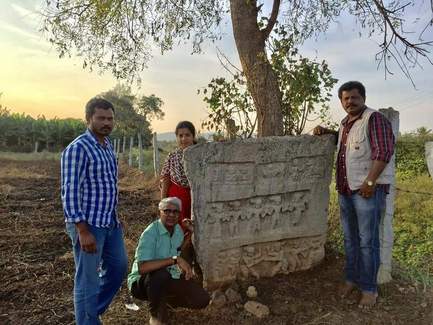
Spearheading the heritage club at the Chikkahalli Government High School in Erode’s Thalavadi, John Peter has been credited with discovering many monuments, sculptures, stone-age tools and inscriptions in their village. His interest has led many a student and fellow villager to finding and preserving these relics.
While employed at the school as a physical education teacher, John has a diploma in Epigraphy (the study of inscriptions) and Archaeology. His interest in the subject spread to his students through the school’s Thonmai Paathukappu Mandram (Heritage Preservation Club). While an order to constitute such clubs was issued over a decade ago, this school got one just five years ago. However, they made for the lost time with fervour and eagerness.
Treasure hunt in the village
As part of the activities of the heritage club, John takes the students out to the neighbouring villages of Igalore, Marur, Kondipuram and Doddapur in search of archaeological remains. It was during one such visit, they found a celt (a long, thin, prehistoric tool made of stone or bronze) of the palaeolithic period — dating back by 10,000 years — on the riverbank near the school. the children, who got to handle the tool instead of just learning about it, we’re able to understand it better, he says.
Hooked to history
What surprised John when he began this venture at the school was that many people did not know about the historical significance of the stones and sculptures found scattered across the village. “When land is being cleared, ancient remains are also demolished along with other structures. I took it as my responsibility to find and preserve them. My aim is to spread awareness about the preservation of the historical remains to uphold the region’s legacy,” he states. In the business of preservation. Towards this end, he has taken to documenting the heritage that is found in abundance in this part of the hills. He calls it ‘marainthu kidakkum malaigalin varalaru’ — the history of the hidden mountains. As part of the activities of the heritage club, John takes the students out to the neighbouring villages of Igalore, Marur, Kondipuram and Doddapur in search of archaeological remains. It was during one such visit, they found a celt (a long, thin, prehistoric tool made of stone or bronze) of the palaeolithic period — dating back by 10,000 years — on the riverbank near the school. The children, who got to handle the tool instead of just learning about it, we’re able to understand it better, he says.
oon, it was not just students who began accompanying him on his ventures. Villagers too took interest in his work and the region heritage abundance. Present-day Thalavadi is covered with forests and hills and shares a border with Karnataka. Centuries ago, it was ruled by many powerful kingdoms. This has left the region with many relics from the Ganga Dynasty, the Hoysala and the Vijayanagara empires. John and his fellow enthusiasts have found at least 13 relics of historic importance — cists and slab cists (coffin or burial chamber and ground), celts, cairns (man-made stone piles), sculptures and monuments. If any of their finds is in need of restoration, John and his team do it themselves.
The ‘Sati stone’ now on display at the school is one such relic. They came across the stone in Chikkahalli. It was found to belong to the 16th century. The dancing woman engraved on the stone looks like an artist performing Yakshagana — a traditional theatre form from Karnataka that is performed even today. It was this team that recovered the broken stone and restored it to something close to its original structure.
The team also restored a hero stone of a Vijayanagara chieftain — Dhimmanayakar, who had lived in the 15th-16th century. A hero stone dedicated to a cattle rider of the Ganga Dynasty and dating back to 8th or 9th century was discovered. A memorial of the 13th-14th century Hoysala Empire chieftain Ragutharayan is also one of their finds, John details.
Soon, word of John’s endeavours spread among the archaeological circles of Chennai, Coimbatore and Erode. Many enthusiasts from these places have now started accompanying him during excavations.
Article Credit: edexlive
